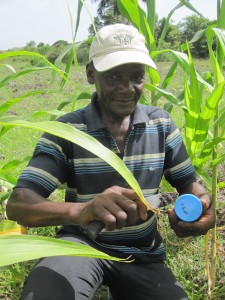Arresting environmental decline in Haiti: Learning about Conservation Agriculture
The farmlands of Haiti’s Central Plateau are severely degraded, limiting small-scale farmers’ ability to produce food and feed for home and market. SANREM CRSP researchers, together with NGO and government partners, are promoting better environmental stewardship by working with Haitian farmers to apply the concepts and practices of conservation agriculture (CA) and ultimately to increase soil health and farmers’ yields.SANREM CRSP researchers are studying CA components of minimal tillage, permanent soil cover, and crop rotation. In Haiti, SANREM CRSP Assistant Program Director Michael Mulvaney says, “There’s no institutional capacity [and] there’s no agronomic awareness of CA. [It] is like hitting farmers with an alternative universe.”
In July, Mulvaney visited Haiti with Tom Thompson, Principal Investigator, Conservation Agriculture Production Systems (CAPS) project, and Associate Professor Wade Thomason, all from Virginia Tech. They offered workshops on CA concepts and techniques at the three CAPS project sites in Haiti’s Central Plateau (Corporant, Lachateau , and Maïssade). Participants included nearly 200 local farmers, 40 percent of them women. Women are a key audience because they tend to be early adopters of new technology even if they are not the primary household decisionmakers, according to Mulvaney.
The workshop featured instructors from both Virginia Tech and SANREM’s in-country partners, Zanmi Agrikol, Caritas/Hinche, the Ministry of Agriculture, and the State University of Haiti’s Faculty of Agronomy and Veterinary Medicine. It included lectures, discussions, and demonstrations.
Farmers also visited demonstrations of successful trial plots comparing improved and local maize vaireties. “We are trying to identify varieties that are going to maximize yields in Haiti,” said Mulvaney. “The farmers are very interested because they can go in the field and see the corn that grows well and say “I want that seed.” He added, “Engaging local farmers in our research is a valuable feedback loop for determining what works, what doesn’t work, what’s adoptable.” For example, farmers did not like a tropical legume [mucuna pruriens] thought by researchers to be a promising cover crop. Mulvaney noted, “If the farmers aren’t interested in it, that’s good for us to know. Farmer feedback is invaluable for designing an adoptable CA system,” since an ineffective recommendation can have disasterous results.
The success of these CA workshops suggests that future workshops will be well-attended and that adoption of CA will lead to greater food security for these Haitian communities.

